| Make no mistake about it, the four-stroke dirt bike revolution is in full swing. Yamaha took the first punch with their YZ and WR 400 machines last year. Both bikes were light (for four strokes) and very fast, with state of the art suspension, a solid chassis and an incredible value. It was better than many exotic hand built one-off four stroke project bikes.
Honda had been frustrated with their potential answer to the Yamaha. First off, there was a huge internal battle within the ranks of Honda R & D. Some people wanted to build a serious race bike to meet the Yamaha challenge. Others felt that the Honda philosophy must be adhered to; that is, build four-stroke off-road bikes and two strokes for motocross racing. The purists won out, and the new XR650R stayed the course. It was still a heavy bike, but modernized to make it a great bike. And, above all, it appears to be as reliable as a claw hammer. It's the kind of bike you can abuse, thrash, ignore and beat the snot out of, and it'll still keep running on gas that would gag a 30-year old lawnmower. Honda knows that many XR owners ride only when they can squeeze the time out of their busy schedules. Therefore, an XR might sit in the garage for a month, and then get taken out for a fun trailriding session with some friends for a weekend. Sure, some people race XRs. Most of them do this in the desert or cross country events, where these big, heavy and powerful bikes can stretch their legs. There are a few mutants, like Scott Summers, who can actually race an big XR in the woods, but these are far and few between. OK, so the prime players in the four stroke game were established. Yamaha with a very serious pair of racers, and Honda with a brilliant all-around off-road/play/fun/trail/Baja/cross-country bike. Then the rumors of the new KTM four strokes surfaced. Everyone knew that KTM had the technology to make a pure world level world beater, as they took the title with one of their hybrids. However, people wondered just what the production four strokes would be like. Would they compete with the Yamahas, or take the "easy" route and make a nice heavy range of bikes to compete with the XRs? MAY WE HAVE THE ENVELOPE, PLEASE? Well, we got a chance to ride four of the new KTM thumpers recently, and we'll spill the beans right up front: these are absolutely deadly serious race bikes! If you're looking for something to go trail riding with your buddies, please look elsewhere. KTM even issued a bulletin to their dealers warning customers of buying these bikes for the wrong reasons. Here's that bulletin, in its entirety: KTM SX & EXC Racing Four Strokes Product and Sales Knowledge Report
It's utterly amazing that a company could be this honest. Better than honest: blunt to the point of saying this just might be too much bike for you!
| |||||||||||||
|
BASIC FACTS ABOUT THE RACING FOUR STROKES KTM is offering two basic engine sizes for 2000; the 400 and the 520. The SX version is for MX and Supercross racing, while the electric-start EXC models are designed for enduro and/or cross country racing. FRAME As far as its basic structure is concerned, the main frame of the SX and EXC Racing models precisely corresponds to the frame geometry of the KTM 2-stroke models. Only the split cradle down tube sections, which were adapted to the 4-stroke engine, and a few retaining brackets, were slightly modified. The sub-frame is made of aluminum and fixed to the main frame by means of a screw connection. FORK
The 2000 Racing models are equipped with the new 43 mm WP USD (Up Side Down) fork, which is a multi-adjuster fork, which means that both the compression damping and the rebound damping can each be separately adjusted on either fork tube, thus offering an enormously large regulating range. The WP USD 43 fork is very light and has different internal settings for the SX and the EXC models, respectively. The forged fork leg axle clamp is lightweight and offers maximum ground clearance. A newly designed 180 degree fork protector gives good protection to the USD tubes. PDS SHOCK The WP PDS Shock 2000 is specifically racing-adjusted for both the SX and the EXC design. HANDLEBAR MOUNTING SYSTEM The top triple clamp is forged with an undamped, variable position, handlebar clamp system. The handlebar clamps can be attached in two optional positions to the triple clamp (i.e. front and back position). Additionally, the handlebar clamp itself, with a diameter of 28 mm, has an eccentric bore, giving you six different handlebar positions. The tapered handlebar is a new Magura Aluminum item.
Footpegs of the SX models are 10 mm longer to reduce the danger of slipping and ensure that the rider is supported squarely, especially on landings from high and long jumps.
SWINGARM These Racing models have a new swing-arm with a rounded profile and new axle passage. The chain adjusting mechanism can be rotated 180 degrees to allow rapid changing of final drive sprockets. Milled marks allow precise chain adjustment and exact rear wheel alignment. BRAKES The rear brake cylinder of the Racing models has a smaller piston diameter (12 mm), which gives the rider a significantly better opportunity to apply the precise amount of brake pressure required. Front brake levers of the SX models are provided with a spring preload feature, which not only allows exact adjustment of the lever position, but also keeps the lever precisely in the selected position.
A new design front wheel brake caliper and caliper support will not flex and in combination with the new Toshiba brake linings (which have 10 % more braking power), the best possible brake performance is realized.Special shaped brake disks include features that limit the accumulation of dirt to a minimum. A cambered outer radius ensures that dirt particles, which tend to accumulate above the slots, are removed. Wedge-shaped slots, which protrude beyond the path of the linings, cause the dirt particles to drift off toward the inside. The brake discs are mounted directly at the hubs. Those of the EXC models have the magnet directly integrated. HUBS/FRONT AXLE
The new bikes have lightweight and nickel-plated front and rear hubs. The front hub is equipped with a larger 20 mm front axle (previously it was 17 mm) that is required by the 43mm WP fork. The new axle increases frontal rigidity and adds stability allowing the front fork to work at its optimum. SPOKES New, lightweight 4.5mm double-tapered spokes are in the front wheel, and extra strong 5mm spokes are laced in the rear. Spokes are chrome-plated for corrosion resistance, and should continue the reputation of strength and durability KTM wheels are famous for. MAIN SILENCER SX and EXC silencers are the same as far as diameter and length are concerned. However, their interior components are different and adapted to the respective requirements. LOOKS Racing models SX and EXC are designed to match the look of the 2-stroke sport models. The basic color combination is orange/silver. The design of the 2000 models is familiar from the Motocross World Championships: highly fashionable retro design in silver/black. A matching non-skid seat cover is available on SX models. SX models are additionally provided with white number plate backgrounds. SIDESTANDS EXC Racing models are equipped with aluminum side stands. No stands are on the SX bikes. TIRES SX and EXC Racing models all come with Bridgestone tires. RIMS SX bikes come with Excel (19" Rear) and EXC bikes are equipped with D.I.D. (18" rear). ENGINE KTM Racing models are equipped with a totally new engine, with new centercases, new transmission, new head, new cylinder, new side covers; everything is new! The kickstarter is located on the right side of the engine. The original starting point of development, the Husaberg engine, has virtually disappeared. The clutch is the only component that has not been changed. All other components were developed by KTM and are totally innovative: Weight difference between the SX and the EXC model is approximately 8 kg. The total weight of the 520 EXC (ready to ride, but without gasoline) is approximately 115 kg/246.8 lbs (dry weight approx. 112 kg), the total weight of the 520 SX (ready for operation) is approximately 107 kg/235.9 lbs. CENTERCASES Sand-cast aluminum centercases are considerably stronger (up to 20 % more) than die-cast cases. The surface of the bottom of the cases is flat (like a skidplate) thus largely preventing the engine from catching on uneven terrain. For optimal heat dissipation, the centercases have no surface coating.
The new 4stroke Racing engine is narrower than the current KTM 2-stroke engines. Sprocket alignment is the same as in KTM 250cc 2-stroke models, but the transmission cases are 12 mm narrower on the right side (clutch side). The ignition cover and the clutch cover are made of lightweight magnesium and powder coated. TRANSMISSION Transmission components are not mass-produced, but cold-sunk, which is an extremely accurate forging technique that ensures top quality and durability with minimal machining. The SX version has 4 speeds, and the EXC version has 6 gears. Conversion is relatively easy and requires only 2 gear wheels. ELECTRIC STARTER The SX version is equipped with a kickstarter, while the EXC version has an additional electric starter. The electric starter is located directly behind the cylinder and engages on the primary gear side. It's a lightweight system and the starter engine weighs only 0.88 kg. By comparison, the small electric starter of the LC4 weighs 1 .2 kg, and the Husaberg starter an even 2 kg. Therefore, an extremely light 4 Amp battery can be used. This battery is mounted in the air filter box. In addition to the automatic decompression (all models), the bikes also feature a hand decompression lever. ENGINE LUBRICATION All of the new Racing models are equipped with 2 oil pumps. The first oil pump draws oil from the gearbox and is filtered via two paper filters. Oil is then pumped simultaneously to the camshaft (also lubricating the top end) and to the crankshaft. The second oil pump returns oil from the crankcase to the transmission system. All oil lines - but one - are integrated into the centercase. There is a total of 7 integrated lines. Integrated oil lines are less likely to be damaged and significantly reduce the overall weight. An oil level viewer replaces the oil dipstick. A microfilter is integrated into the centercases. The new Racing engine is unique in its central, low-weight ventilation system, which works via the balancer shaft. A centrifugal oil interceptor prevents oil from leaking out of the engine through the ventilation openings. INSIDE THE ENGINES The 520 engine is equipped with a forged piston. Components are top quality: precision-forged rocker arms, nitration-hardened valves, progressively wound valve springs on a two-spring system basis, aluminum spring retainers with special valve guide seals as well as case-hardened adjusting screws. The timing chain is narrow, divided and riveted. The cylinder, in contrast to the LC4, mounts in unison with the cylinder head to the centercases, which means a weight reduction of more than 1 kg for the cylinder alone. Crankshaft design uses needle bearings for the conrod and a silver-plated cage, as well as roller bearings. All of these new four stroke Racing engines are equipped with a balancer shaft. IGNITION SYSTEM Racing models are equipped with a digital Kokusan ignition system. The SX version weighs 0.4 kg less than the EXC version. Flywheel diameter is 80 mm in 400 SX models and 106 mm in 520 SX and 400/520 EXC models. CARBURETOR The Racing carburetor is a Keihin with a throttle position sensor. In combination with the digital ignition system, information on both the current r.p.m. and throttle position is transmitted to the ignition box. The ignition curve is optimized for every load condition, which improves engine response and reliability. COOLING Racing models have a high capacity water pump integrated into the cylinder head. The head flow pattern is guided around both the intake and the exhaust port channels. CLUTCH Racing models have no separate outer clutch hub. The function of the outer clutch hub is performed by the clutch gear. Therefore, the clutch is extremely narrow, using thin clutch discs. OIL MAINTENANCE Each of the two oil pumps is additionally protected by an oil screen of its own. These screens can be removed from outside and easily cleaned. They are sealed with reusable O-rings. The oil pressure relief valve is integrated and accessible from outside. Maintenance on all four of the bikes is identical. You'll find four filters in the lubrication system. Two of them are replaceable items and the other two are cleanable screens. Only one oil line of the seven is not built in to the center cases, which saves weight and eliminates oil leaks. There's an oil level viewer to check the level, rather than a conventional dipstick. Only 1250 ccs of oil is required, and frequent oil changes are recommended for longer engine life. THE BOTTOM LINE After riding all of the bikes, we are duty bound to tell you to think about the EXC models first, unless you plan to do some very heavy-duty MX or SX racing. The SX models are powerful, light, sophisticated machines not designed for those with limited skills.
Of course, they're fun to ride and will give you a thrill that's hard to match. But if you think you want to buy a 520 SX to go out and have fun with your trail riding pals, it won't take you very long to realize the bike is over-kill and your buddies will probably beat you on their three year-old bikes, as you fight to keep the 520 SX from spitting you off the back. It's a brute, pure and simple. In the right hands, it can win a GP in stock trim. In the wrong hands, you're going to wish you had put that deposit down on that XR Honda instead. If you consider the 520 EXC, you'll more than likely fall in love with the bike. While considerably more user-friendly than the 520 SX, it's still a very powerful bike that has the ability to open your eyes wider than nature intended. And yes, there is that electric starter, old friend. On the list of "Bikes I Want," the 400 SX is last in this group of four. Why? Not because it's bad in any way, it's just that it's as twitchy and nervous as the violent 520 SX, but doesn't deliver the same cheap thrills. I figure as long as you're going to scare yourself, you might as well scare yourself halfway nuts. It would be hard to go wrong with the 400 EXC for an all-around race/off-road bike. You could enter an enduro with this bike, and race a local MX just by removing the nicely tucked-in sidestand and putting the headlight/number plate on the workbench. Still, when you think four stroke, it's hard to argue against a big-inch thumper. Therefore, all things considered, I would lay my personal money down for the 520 EXC and immediately get my forearms into some serious condition so I could learn to hang onto this thing. The real bottom line is that KTM has just re-written the rulebook on the future of four strokes. KTM Sportmotorcycle USA, Inc. | |||||||||||||

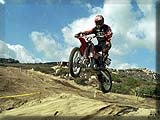
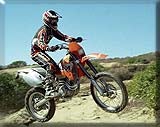
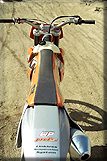
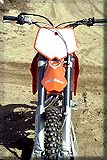
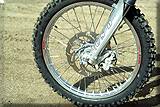
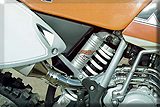
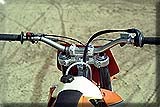
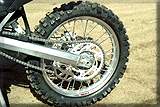
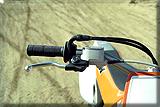
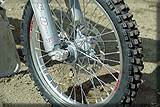
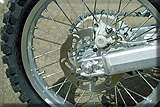
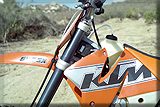
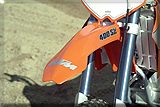
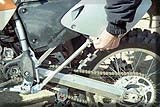
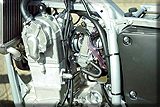
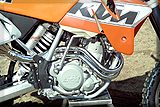

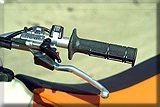


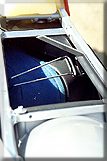

 Your Privacy Choices
Your Privacy Choices